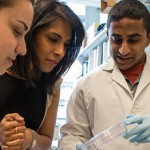
In the middle: Sangeeta Bhatia, John J. and Dorothy Wilson Professor of Health Sciences and Technology and of Electrical Engineering and Computer Science, MIT
Sangeeta Bhatia, Nancy Hopkins, Susan Hockfield | Science Editorial
In 1999, the Massachusetts Institute of Technology (MIT) released a study that documented how women faculty in its School of Science were afforded fewer resources and opportunities than men—a discrepancy it attributed to unconscious biases that had marginalized women faculty “even in the light of obvious good will.” The report inspired policy changes at universities across the country that have made faculty resources more equitable. But a study released last month by MIT members (including the authors of this editorial) of the Boston Biotech Working Group (BBWG) now documents a similar problem at the interface of academia and industry: Fewer women than men faculty at MIT move their research discoveries into companies, and fewer serve as scientific advisers or on boards of directors. This disparity holds back women faculty and denies the full promise of innovation to the universities they work for, the biotech industry, and society at large.
In 2019, the BBWG brought together a diverse group of biotech and biopharma participants to investigate the situation. The results are sobering, if not surprising. In contrast to their male peers, women in the biological sciences at MIT rarely start biotech companies or sit on their boards. This is true despite an increase in women faculty with qualifications equal to those of their male colleagues. A 2018 study from Stanford University, led by Ann Arvin, described a similar finding at that institution. The BBWG study focused on only 7 of the 14 departments in MIT's Schools of Science and Engineering, but even so it arrived at a remarkable conclusion: Had the women in those departments participated in founding companies at the same rate as the men, they could have started roughly 40 additional companies helping to predict, prevent, and treat disease.
Just as sobering are the stories of women faculty being passed over as cofounders and scientific advisers, and left out of networking events, leaving them on the sidelines of an emerging ecosystem that is critical both to advancing their discoveries and to propelling the careers of their trainees. Some describe feeling “invisible” in spite of their expertise, and others have been advised to take along male students or post-docs when pitching for capital to be taken more seriously.
What can be done? A first step is to acknowledge the importance of network effects. Many social and professional groups remain inaccessible to women. Such networks mediate how money is raised, how teams are assembled, and how people learn about the commercialization process. Women in the biological sciences with ideas ripe for the market clearly don't enjoy equal access to these networks—in 2019 only 2.7% of US venture capital dollars, for example, supported women-founded companies. As concerning, the lack of network access is even greater for women (and men) of color.
To address these imbalances, the BBWG launched several programs that could be easily replicated at other universities. Its Future Founders Initiative convenes boot camps where aspiring women academic entrepreneurs can get candid advice from experienced founders. Its “VC Pledge” invites venture capital groups to commit to achieving, within 2 years, a goal of at least 25% women on the boards of companies that they influence. Its Accelerator Fellowships offer tenured women faculty the chance to spend time at venture capital firms, watching ideas get vetted and deals get done. The BBWG Data Group has created a framework to quantify faculty participation in the entrepreneurial ecosystem and potentially reveal points of intervention. For example, MIT and Stanford data show that women and men faculty in some engineering departments are starting companies at similar rates, suggesting that adjusting departmental “microclimates” may be helpful.
The MIT study complements other efforts in academia and the broader ecosystem. Washington University's Equalize is a national pitch competition that pairs academic women inventors with experienced mentors to turn ideas into start-ups. The Mass General Brigham Innovation office sponsors board director candidate workshops and an Innovation Academy for prospective founders. To increase access to capital, angel groups and accelerator funds, such as MassNextGen and AIM-HI, and networks of women venture capital investors seek to increase women's participation. And Equality Can't Wait, founded by philanthropists Melinda Gates and MacKenzie Scott, aims to expand women's influence.
These programs could address another challenge: underrepresentation of minority faculty in tech transfer. The discoveries women and minority researchers are making today have great potential as a force for good in the world—but reaching that potential is only possible if paths to real-world applications are open to everybody.
* Originally published here.
-
1Sangeeta Bhatia is the Wilson Professor of Engineering and director of the Marble Center for Cancer Nanomedicine at MIT, Cambridge, MA, USA. Bhatia is an HST faculty member, and a graduate of HST.
-
2Nancy Hopkins is Amgen Inc. Professor of Biology emerita at MIT, Cambridge, MA, USA.
-
3Susan Hockfield is President Emerita, professor of Neuroscience, and a member of the Koch Institute for Integrative Cancer research at MIT, Cambridge, MA, USA.